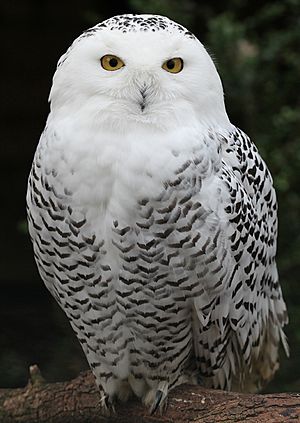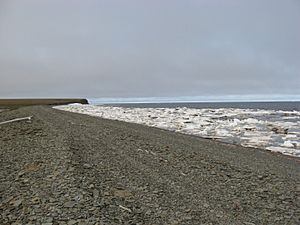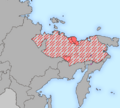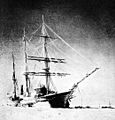Laptev Sea facts for kids
The Laptev Sea is a part of the Arctic Ocean. Think of it as a big bay or arm of the ocean. It's located off the northern coast of Siberia, a huge region in Russia. To its west is the Kara Sea, and to its east is the East Siberian Sea.
This sea was named after two Russian explorers, Dmitry Laptev and Khariton Laptev. It's a very cold place! Temperatures stay below freezing (0 °C or 32 °F) for more than nine months each year. The water isn't very salty, and because of the harsh conditions, there aren't many plants, animals, or people living there. Most of the Laptev Sea is quite shallow, less than 50 meters deep. It's usually frozen, but you can sometimes see clear water in August and September.
People have lived along the shores of the Laptev Sea for thousands of years. Early tribes like the Yukaghirs, Evens, and Evenks lived here. Later, Yakuts and then Russians settled in the area. Russian explorers first arrived in the 1600s. They traveled from the south along several large rivers that flow into the sea. These rivers include the Lena River, the Khatanga, the Anabar, the Olenyok, the Omoloy, and the Yana. The sea also has many islands, and some of them have amazing, well-preserved remains of mammoths!
The biggest town and port on the Laptev Sea is Tiksi.
Contents
Plants and Animals of the Laptev Sea


Life in the Laptev Sea is tough because of the very cold climate. Both plants (flora) and animals (fauna) are not very common here.
Tiny Ocean Life
Most of the plant life in the sea itself is made up of tiny, one-celled organisms called diatoms. There are over 100 different kinds of diatoms! You can also find about 10 types each of green algae, blue-green algae, and flagellates. The tiny plants floating in the water, called phytoplankton, are usually found in water that's a bit salty, like where rivers meet the sea. There are also about 30 kinds of tiny animals floating in the water, known as zooplankton.
Plants on the Coast
The plants growing on the land along the coast are mostly mosses and lichens. You can also find a few flowering plants like arctic poppy, Saxifraga, Draba, and small groups of polar and creeping willows. Some rare plants include types of Cerastium and Saxifraga.
Animals of the Laptev Sea
Many amazing mammals live in or near the Laptev Sea all year round. These include the ringed seal, bearded seal, Harp Seal, walrus, collared lemming, Arctic fox, reindeer, wolf, ermine, and Arctic hare. The mighty polar bear also calls this region home. The beluga whale visits the area during certain seasons.
There are also many kinds of birds. Some birds live here permanently, like the snow bunting, purple sandpiper, Snowy Owl, and brent goose. Other birds gather in large groups on the islands and shores. These include the little auk, Black-legged Kittiwake, black guillemot, ivory gull, and glaucous gull. You might also spot skuas, sternas, Northern Fulmars, Ross's Gulls, Long-tailed Ducks, eiders, loons, and Willow Grouse.
Fish Species
The Laptev Sea is home to 39 types of fish. Most of these fish like slightly salty water. Some of the main fish you'll find are grayling and different kinds of whitefishes, like muksun, broad whitefish, and omul. Other common fish include sardines, Arctic ciscos, Bering ciscos, polar smelt, saffron cod, polar cod, flounders, arctic char, and inconnu.
Nature Reserve
To protect this unique environment, the Ust-Lena Nature Reserve was created in 1985 in the delta of the Lena River. This reserve is very large, covering 14,300 square kilometers. In 1986, the New Siberian Islands were also added to the reserve. This protected area is home to many different living things: 402 plant species, 32 fish species, 109 bird species, and 33 mammal species.
Images for kids
See also
 In Spanish: Mar de Láptev para niños
In Spanish: Mar de Láptev para niños










